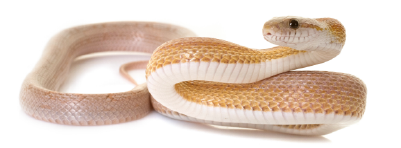 |
| Printable Version: Fluker's Corn/King Snake Care Sheet and Product List (PDF) |
Download |
| Video Tutorial: Fluker's Corn/King Snake Setup & Care Tips with Dr. Mark Mitchell (YouTube) |
Watch Now |
Corn/King Snake Habitat Setup and Care |
|
Snakes are one of the cleanest, most peaceful, and easiest to care for pets to look after, specifically king snakes and corns snakes because they’re usually smaller and require very little to stay happy and healthy. Before bringing your new snake home, be sure to have all your supplies such as housing, accessories, and food. This will help ensure your pet has a smooth and healthy transition into your care. Quick Facts● Snakes are carnivorous. They can’t bite their food, so they swallow their prey whole. ● They have flexible jaws that allow them to eat prey much bigger than their heads. ● Snakes can range in size from the tiny, 4-inch-long thread snake, to pythons and anacondas over 23 feet long. ● Snakes don’t have eyelids, and their ears are internal. ● In captivity, snakes can live for 25-50 years! |
EnclosureIn contrast to other pet reptiles, snakes often do better in smaller environments. Bigger homes can make your pet snake anxious. Most snakes will be happy in a 20-gallon tank. Multiple snakes should be housed separately to avoid territorial disputes, challenging feeding, and even cannibalism among some breeds! Be sure your terrarium has a secure lid to prevent your snake from escaping. |
SubstrateAcceptable substrates run the gamut from reptile bark to reptile carpet. You can also use recycled paper or layers of newspaper. Spot clean your chosen substrate every day and replace it every 1-2 months. |
AccessoriesProvide a wide, shallow water dish for your snake to soak in. Snakes love hiding and climbing, so you’ll want to stock the tank with branches and vines. Add a rock or wood hiding place on the side of the terrarium that will be the cool side. This is where your pet will go to relax and feel safe. |
Temperature & LightingSnakes are cold-blooded and need a heating source to regulate their body temperature and ensure their optimal health. Your snake's terrarium should have a warm side and a cool side. By day, keep the warm side 80-85°F and the cool side 70-75°F. You can use under-tank heating or overhead heat bulbs to maintain this gradient. At night, the entire terrarium should be 65-70°F. Monitor temperature with two thermometers, one on each side. King/corn snakes are nocturnal, but they need lighting that mimics day and night. Use a fluorescent bulb in the habitat to mimic daylight for 12 hours a day. At night, switch to a night-specific bulb so you can watch your pet with minimum disturbance. |
Diet & NutritionProvide a water dish large enough for the snake to soak in. This will give your pet plenty of water to drink, help raise ambient humidity, and aid in shedding. All tap water used should be treated with a water dechlorinator. Change the water once a day. Pet king/corn snakes are primarily kept on a diet of rodents. When possible, feed them frozen or thawed mice/rats over live. It’s more convenient and eliminates the chance of live prey harming your pet. For young snakes, one baby mouse a week is enough. When they get a little older, offer one regular sized mouse a week. A liquid vitamin is an excellent supplement for carnivores. It provides important vitamins and electrolytes that aid in shedding and can be sprayed directly onto the animal's prey. |
Handling & SafetyKing snakes and corn snakes are generally very easy to handle. To be on the safe side, always avoid being too rough or making sudden movements when handling your pet. Don’t handle young snakes more than once a week or so. Make sure to wait several days after feeding your snake before handing it – this allows the snake to digest its prey. Contact a vet if you notice any of these symptoms of illness or distress: more time spent hiding, eating/drinking less, weight loss, shedding problems, discolored skin, discharge from the eyes, nose, or mouth, labored breathing, paralysis of limbs, or abnormal feces. |


